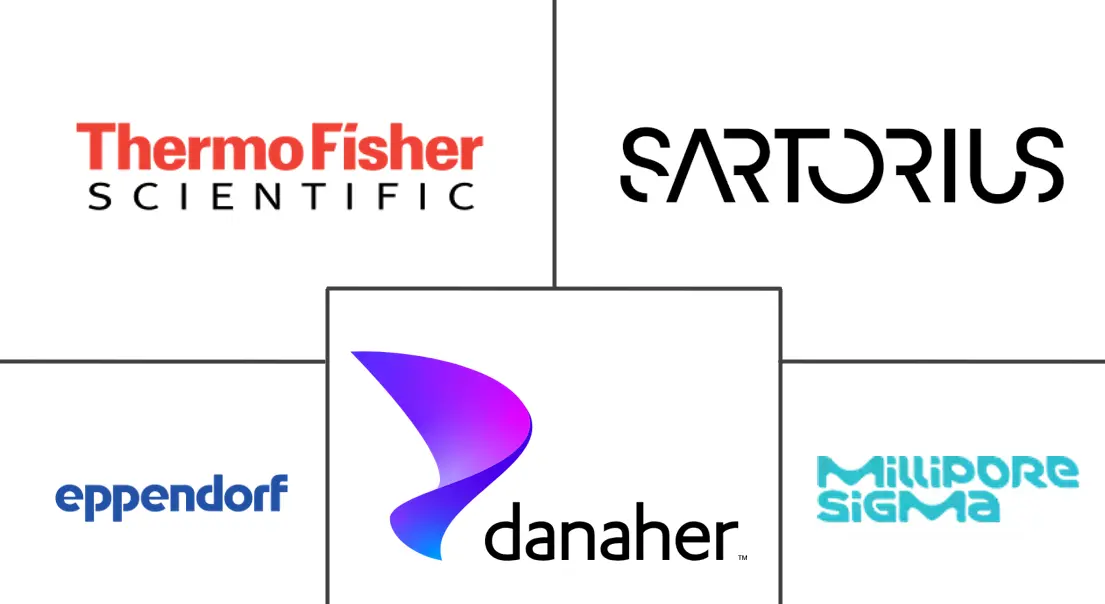Bioreactor Market Size and Share
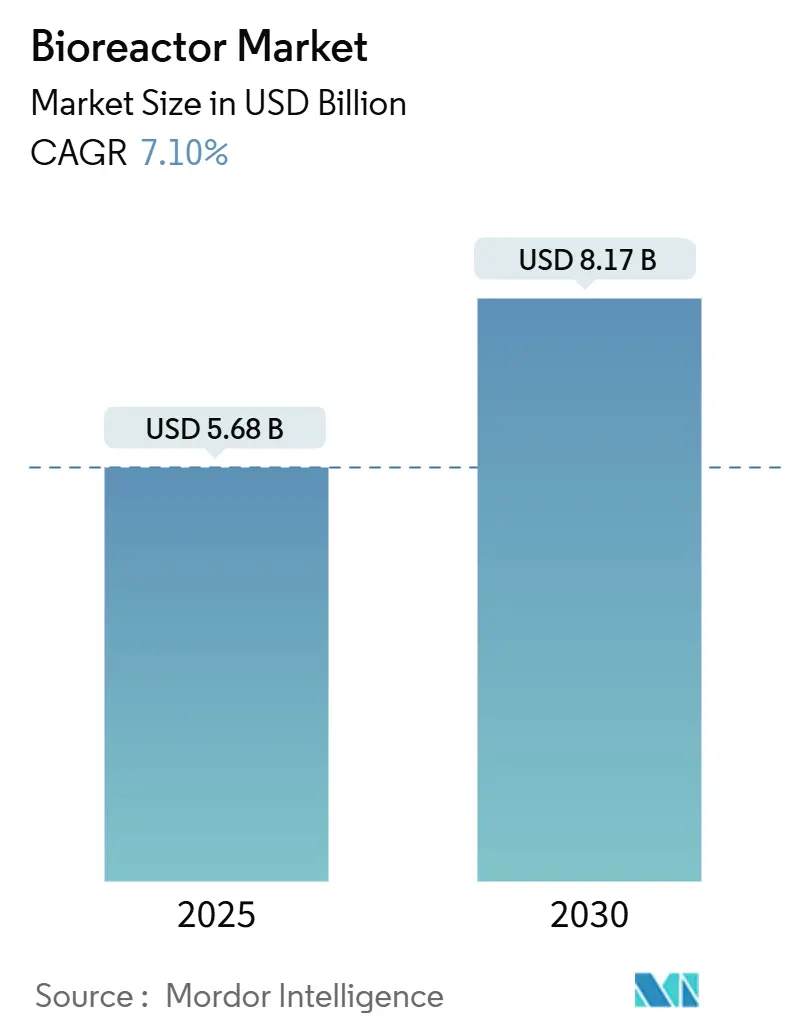
Bioreactor Market Analysis by Mordor Intelligence
The global bioreactor market size stood at USD 5.68 billion in 2025 and is projected to reach USD 8.17 billion by 2030, advancing at a 7.10% CAGR during 2025-2030. Sustained demand for complex biologics, a rapidly expanding pipeline of cell- and gene-therapy candidates, and steady improvements in process-control technology underpin this growth trajectory. Suppliers that balance flexibility with scale continue to gain ground because stainless-steel, single-use, and hybrid systems each solve distinct production challenges. Automated control is now the default configuration for new installations, and AI-driven analytics are moving from proof-of-concept trials to routine manufacturing, improving batch consistency and reducing downtime[1]Source: Eric S. Langer, “Trends in Perfusion Bioreactors,” BioProcess International, bioprocessintl.com. Regional dynamics are also shifting: Asia’s accelerated build-out of cGMP capacity is reshaping global supply chains, while North America maintains the largest installed base and remains the launchpad for next-generation technologies.
Key Report Takeaways
- By type, stainless-steel vessels held 47.0% of the bioreactor market share in 2024, while single-use systems are projected to grow at a 10.1% CAGR through 2030.
- By usage, full-scale production units captured 58.8% of 2024 revenue; pilot-scale production is forecast to expand at a 9% CAGR to 2030.
- By scale, 200 L–1,500 L reactors accounted for 39.0% of the bioreactor market size in 2024, whereas volumes above 1,500 L are set to rise at a 10.2% CAGR during 2025-2030.
- By control type, automated (MFC-based) systems commanded 64.0% share in 2024 and are expected to maintain an 8.5% CAGR over the forecast period.
- By bioprocess, fed-batch processing led with 52.0% of 2024 revenue; continuous processing is anticipated to advance at a 10.5% CAGR through 2030.
- By application, pharmaceutical and biopharmaceutical manufacturing dominated with 72.0% of 2024 revenue, while cell- and gene-therapy use cases are poised for a 10.8% CAGR to 2030.
- By geography, North America retained 43.0% of the bioreactor market share in 2024, whereas Asia is projected to register an 8.3% CAGR from 2025 to 2030.
Global Bioreactor Market Trends and Insights
Drivers Impact Analysis
| Driver | (~) % Impact on CAGR Forecast | Geographic Relevance | Impact Timeline |
|---|---|---|---|
| Rapid capacity expansion for cell & gene therapies | +1.2% | North America, Europe, Asia | Long term (≥ 4 years) |
| Modular closed-system facilities in emerging markets | +0.8% | Asia, Latin America | Medium term (2-4 years) |
| Shift toward continuous bioprocessing | +0.9% | Global | Long term (≥ 4 years) |
| Government incentives for vaccine biomanufacturing | +0.4% | Middle East & Africa | Short term (≤ 2 years) |
| Collaborative CDMO outsourcing driving single-use uptake | +0.5% | Latin America | Medium term (2-4 years) |
| Technological advancements in bioreactors | +1.0% | Global | Long term (≥ 4 years) |
| Source: Mordor Intelligence | |||
Rapid Capacity Expansion for Cell & Gene Therapy Manufacturing
Developers of cell- and gene-based products have quickly exceeded the capabilities of legacy monoclonal-antibody equipment. Novel high-density platforms such as Corning’s Ascent Fixed-Bed Reactor supply extensive surface area for adherent cultures while preserving a compact footprint, easing viral-vector bottlenecks[2]Corning Life Sciences, “Fixed-Bed Bioreactors: Bridging the Gap From Bench to Market,” corning.com. CDMOs value these systems because they scale up rapidly without full facility overhauls. As regulators emphasize modality-specific process understanding, purpose-built bioreactors have shifted from optional upgrades to essential infrastructure, adding measurable uplift to the bioreactor market.
Shift Toward Modular & Closed-System Facilities in Emerging Markets
Manufacturers in Asia, Latin America, and parts of Africa are bypassing conventional clean-room builds by installing prefabricated, closed-system suites that integrate single-use assemblies and skid-mounted utilities. These plants reduce capital expenditure, compress validation timelines, and allow faster entry into global supply chains. Their portability also lets CDMOs relocate or expand with minimal disruption, a benefit proven during pandemic-related shortages. The distributed model lowers freight risk and brings production closer to patients, broadening the bioreactor market footprint across more locations.
Rise of Continuous Bioprocessing Platforms
Continuous perfusion, long considered experimental, is becoming commercial reality as cell-retention devices and online analytics mature. By maintaining cultures in peak metabolic phase, perfusion reactors boost volumetric productivity and can trim facility footprints by up to 75%. Steady-state operation improves batch consistency, a critical advantage for degradation-prone molecules. Linking continuous upstream steps with synchronized downstream purification creates end-to-end flow that reduces hold times and elevates quality, reinforcing adoption momentum in the bioreactor market.
Government Incentives for Vaccine Biomanufacturing in Middle East & Africa
Governments across the region now offer tax holidays, subsidized land, and dedicated workforce programmes to establish domestic vaccine plants. Equipment must tolerate intermittent power and variable water quality; single-use reactors meet those needs. Accelerated technology transfer from established suppliers shortens local learning curves and inserts new hubs into the global bioreactor market network.
Restraints Impact Analysis
| Restraint | (~) % Impact on CAGR Forecast | Geographic Relevance | Impact Timeline |
|---|---|---|---|
| Sterilization-integrity issues in large-volume SUBs | -0.60% | Global | Medium term (2-4 years) |
| Shortage of high-quality single-use resin | -0.90% | North America, Europe | Short term (≤ 2 years) |
| CapEx constraints for stainless-steel retrofits in legacy plants | -0.70% | North America, Europe, Asia | Medium term (2-4 years) |
| Complex regulatory validation for hybrid configurations | -0.50% | Global | Medium term (2-4 years) |
| Source: Mordor Intelligence | |||
Sterilization-Integrity Failures in Large-Volume Single-Use Bioreactors
Scaling disposable bags beyond 2,000 L increases stress on seams and film interfaces, raising contamination risk late in production runs. Inconsistent film extrusion and challenges in validating gamma-irradiation efficacy across thicker assemblies remain unresolved. Many producers hedge by pairing single-use seed trains with stainless-steel production tanks, trading some flexibility for sterility assurance. While suppliers are refining test protocols and upgrading materials, the added cost erodes portions of the single-use value proposition, tempering bioreactor market growth.
Global Shortage of High-Quality Single-Use Plastic Resin
Demand for ultra-low-extractable resin has outpaced supply, extending lead times and prompting multi-year procurement contracts. Only a few petrochemical firms meet stringent pharmacopeial standards, limiting near-term capacity expansion. Stockpiling and dual sourcing tie up working capital, while regulatory filings become more complex. Although bio-based materials and recycling programmes may diversify supply over time, current shortages subtract roughly 0.9 percentage points from the forecast CAGR of the bioreactor market.
Segment Analysis
By Type: Stainless steel remains the manufacturing backbone
Stainless-steel vessels captured 47% of 2024 revenue, underscoring their dominance in high-volume and oxygen-intensive applications. Digital-twin retrofits and inline process-analytic-technology arrays are extending asset lifespans, allowing operators to boost throughput without new construction[3]Muhammad A. Chaudhry, “Fluid Flow and Mixing With Bioreactor Scale-Up,” BioProcess International, bioprocessintl.com. Meanwhile, single-use systems have secured complementary roles in seed trains and multi-product suites. Hybrid layouts give manufacturers faster changeovers and reduced cleaning validation yet still rely on stainless for final production. Surface-treatment breakthroughs now lower protein adhesion on stainless walls, and weld-free quick-connect designs reduce installation time. Together, these innovations ensure that both platforms will coexist, each optimized for its comparative advantage inside the bioreactor market.
Recent procurement data show that leading CDMOs sign multi-year agreements only with suppliers demonstrating plug-and-play interoperability between disposable bags and fixed tanks. Although intensified processing raises interest in smaller working volumes, stainless systems retain a clear edge for microbial fermentation and other shear-heavy processes. This balance secures long-term demand for both formats, reinforcing the diversified structure of the bioreactor market.
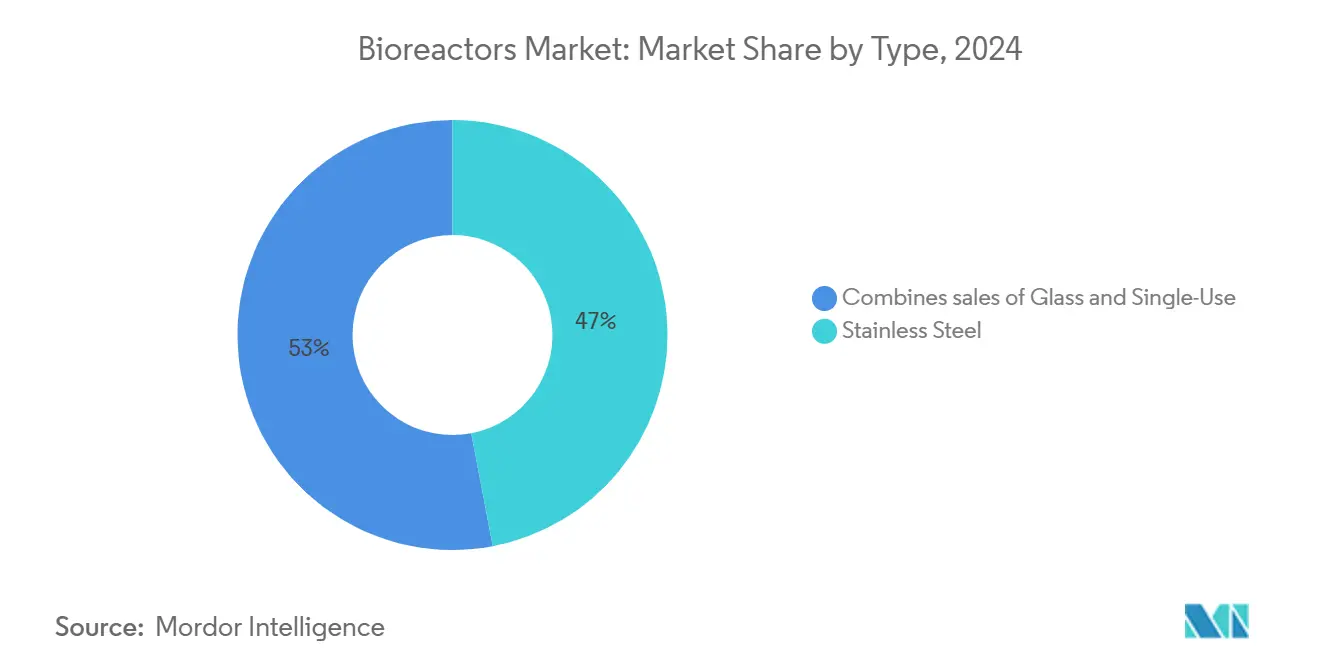
By Usage: Full-scale production drives market value
Full-scale units accounted for 58.8% of 2024 spending, highlighting the revenue concentration once drugs clear regulatory approval. Sponsors use cell-line engineering and media optimisation to elevate protein yields without enlarging footprints. Single-use reactors up to 5,000 L bring flexibility for multi-product plants, while stainless tanks above 10,000 L remain the benchmark for blockbuster volumes. Advanced PAT sensors now provide real-time feedback on pH, dissolved oxygen, and metabolite trends, enabling proactive adjustments that stabilise titers.
AI-driven control suites analyse multi-campaign historical data to predict deviations before they affect yield. For CDMOs running at high utilisation, these tools directly increase billable capacity. Consequently, the bioreactor market sees persistent investment in large-volume equipment even as continuous-processing pilots experiment with smaller footprints.
By Scale: Mid-range volumes capture the manufacturing sweet spot
Reactors in the 200 L–1,500 L range captured 39.0% of 2024 demand, aligning capacity with the needs of targeted biologics and orphan indications. Intensified fed-batch and high-cell-density perfusion strategies now produce yields once attainable only in larger vessels, making mid-range equipment a practical option for commercial launches. Venture-backed biotechs often lease or purchase these reactors to accelerate first-in-human studies and early revenue milestones, anchoring this segment within the bioreactor market size landscape.
Suppliers have introduced chassis that share control hardware across volume sizes, simplifying tech transfer as processes scale. Disposable flow paths embedded in reusable frames combine sterility assurance with cost efficiency. With portability, compliance, and modular expandability baked in, the mid-range segment remains a strategic battleground
By Control Type: Automation redefines process reliability
Automated reactors commanded 64.0% of 2024 sales, reflecting the industry-wide move toward data-centric operations. Embedded analytics interpret sensor streams in real time, comparing them against “gold-standard” fingerprints to flag deviations minutes ahead of impact. Digital-twin simulations now guide scale-up, translating laboratory learnings to production without extensive trial runs. Predictive-maintenance algorithms signal component fatigue well before failure, trimming downtime and protecting batch schedules. These capabilities cement automation as a primary growth engine inside the bioreactor market.
By Bioprocess: Fed-batch dominates commercial production
Fed-batch techniques maintained a 52.0% share in 2024, reflecting their regulatory familiarity and operational robustness. Stepwise nutrient feeds extend culture longevity without the added complexity of perfusion cell-retention devices. Media-formulation breakthroughs now lift titers, helping facilities meet output targets with fewer runs. Hybrid seed-train strategies that use perfusion intensification shorten cycle times yet revert to fed-batch for production, preserving straightforward validation. Continuous processing gains momentum, but most operators see the transition as incremental. In the near term, fed-batch remains central to the bioreactor market.
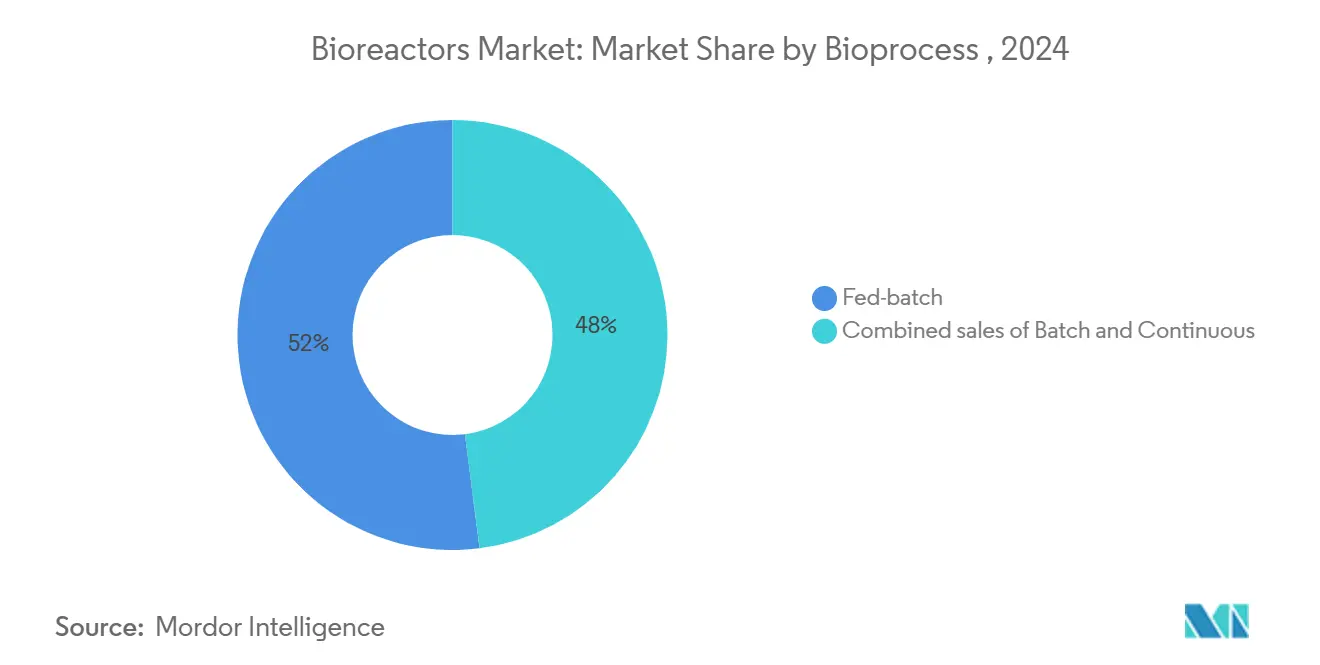
By Application: Pharmaceuticals drive innovation and adoption
Pharmaceutical and biopharmaceutical manufacturing generated 72.0% of 2024 revenue, giving the sector disproportionate influence over equipment design. Complex protein scaffolds demand precise control of post-translational-modification pathways. CDMOs purchase multipurpose suites capable of switching between monoclonal-antibody and viral-vector campaigns in weeks, driving supplier roadmaps toward modular, recipe-based architectures. Aligning upstream reactors with downstream chromatography skids creates straight-through processing that reduces hold steps and safeguards labile molecules, reinforcing pharmaceutical quality standards as the anchor for the bioreactor market.
Geography Analysis
North America captured 43.0% of global demand in 2024, supported by a dense network of research universities, venture capital, and commercial sites that shorten the lab-to-launch cycle. Federal incentives for domestic manufacturing resilience, enacted after pandemic disruptions, fund new capacity that frequently features single-use or hybrid systems. FDA guidance on process-analytical-technology adoption makes advanced monitoring nearly obligatory, boosting orders for sensor-rich reactors. First-in-class therapies such as CAR-T and in-vivo gene editing are typically piloted in the region, ensuring local suppliers remain early providers of specialised equipment to the bioreactor market.
Asia is forecast to post an 8.3% CAGR between 2025 and 2030, the fastest globally. Government-backed industrial parks in China, Singapore, and South Korea provide turnkey utilities and tax incentives that attract multinational innovators. Regional CDMOs combine cost-efficient labour with high-spec facilities, winning global supply contracts. Newly built plants adopt digital workflows from the outset, avoiding retrofit challenges seen in mature markets. Biosimilar producers also energise demand for flexible volumes that support cost competitiveness. Consequently, the bioreactor market is spreading into second-tier cities, broadening the regional manufacturing map.
Europe maintains significant technical clout through leadership in process-development science and advanced-therapy medicinal products. Public grants finance continuous-manufacturing pilots aimed at refining quality-by-design principles. Sustainability mandates spur adoption of closed-loop water systems and energy-efficient jackets. CDMOs specialising in viral vectors and plasmid DNA operate in clusters around Germany and the Nordic states, lifting regional demand for compact yet sophisticated reactors. Harmonised EU regulations accelerate technology transfer, allowing innovations to propagate efficiently among member states and sustaining Europe’s role in the bioreactor market.

Competitive Landscape
The bioreactor market exhibits moderate concentration: the top five suppliers—Sartorius, Thermo Fisher Scientific, Merck KGaA, Danaher, and Eppendorf—collectively hold around 65.0% of revenue. Each is extending its portfolio through acquisitions and partnerships that bundle equipment, consumables, and analytics into integrated ecosystems. Sartorius and Thermo Fisher both promote suites linking upstream reactors with downstream purification skids, raising switching costs for clients and reinforcing platform lock-in.
Smaller innovators thrive in niches such as microbial fermentation, microfluidic perfusion, and organ-on-chip culture, where bespoke requirements deter larger firms. Strategic alliances between multinationals and university spin-outs funnel new technology into commercial pipelines while giving start-ups global reach. Licensing income from proprietary sensors or cell-retention devices supplements revenue for these specialists.
Artificial-intelligence features represent the next competitive frontier. Suppliers embedding predictive-maintenance and adaptive-control algorithms directly into supervisory software report measurable reductions in downtime and deviation rates. Early adopters have secured multi-year master-supply deals with leading CDMOs, setting new performance benchmarks across the bioreactor market. Vendors unable to marry hardware with actionable data risk commoditisation.
Bioreactor Industry Leaders
-
Sartorius AG
-
Thermo Fisher Scientific Inc.
-
Eppendorf AG
-
Danaher
-
Merck KGaA
- *Disclaimer: Major Players sorted in no particular order
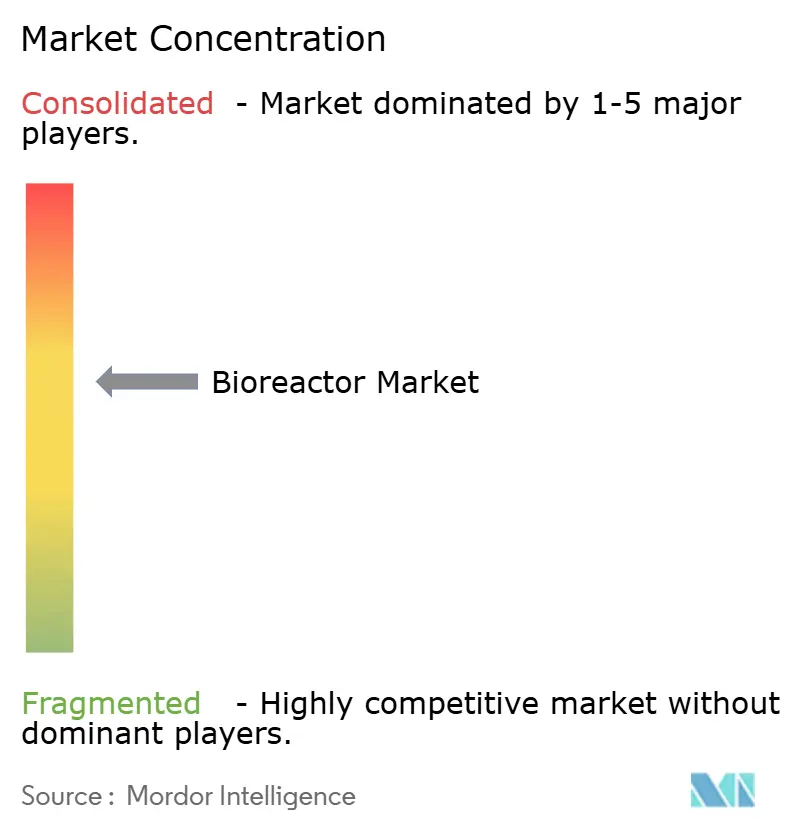
Recent Industry Developments
- March 2025: Thermo Fisher Scientific unveiled the DynaDrive Single-Use Bioreactor, whose stir-tank geometry is optimised for intensified cell culture. The design implicitly reduces shear stress, a critical parameter for high-density perfusion, suggesting an incremental reduction in the cost-of-goods for CGT sponsors.
- January 2025: Iowa State University researchers introduced SMART culture vessels, providing twenty-fold enhanced sensitivity to metabolic shifts. This advance equips bioprocess scientists with earlier intervention windows, limiting yield attrition during scale-up.
- September 2024: IKA launched the HABITAT Research bioreactor, fusing a century of laboratory instrumentation expertise with modern phototrophic and cell-culture capabilities. The unit’s modular architecture hints at a future where research-grade systems morph into pilot-scale assets with minimal retrofitting.
- March 2025: Sartorius Stedim BioOutsource expanded biosimilar testing services by incorporating Thermo Scientific’s Charge Variant Workflow, enabling more rapid charge-variant profiling, a critical attribute for biosimilar comparability.
Research Methodology Framework and Report Scope
Market Definitions and Key Coverage
Our study defines the global bioreactor market as all new vessels of five liters and above that maintain controlled temperature, pH, dissolved oxygen, aeration, and agitation to grow living cells or microbes for commercial manufacture or process development of biologics, enzymes, cultivated protein, and industrial metabolites. Systems covered include stainless-steel, glass, and single-use formats supplied to biopharmaceutical companies, contract developers, food-tech innovators, industrial biotech firms, and academic institutes.
Scope exclusion, waste-water equipment: Moving-bed, membrane, and other effluent-treatment bioreactors, refurbished units, and stand-alone automation skids are omitted.
Segmentation Overview
- By Type
- Glass
- Stainless Steel
- Single-Use
- By Usage
- Lab-scale Production
- Pilot-scale Production
- Full-scale Production
- By Scale
- 5 L - 20 L
- 20 L - 200 L
- 200 L - 1,500 L
- Above 1,500 L
- By Control Type
- Manual
- Automated (MFCs)
- By Bioprocess
- Batch
- Fed-batch
- Continuous
- By Application
- Pharmaceutical & Biopharmaceutical Manufacturing
- Cell & Gene Therapy
- Industrial Biotechnology (Biofuels, Enzymes)
- By End User
- Biopharma & Pharma Companies
- Contract Development & Manufacturing Organisations (CDMOs)
- Other End Users
- By Geography
- North America
- United States
- Canada
- Mexico
- Europe
- Germany
- United Kingdom
- France
- Italy
- Spain
- Rest of Europe
- Asia-Pacific
- China
- Japan
- India
- South Korea
- Australia
- Rest of Asia-Pacific
- Middle-East and Africa
- GCC
- South Africa
- Rest of Middle East and Africa
- South America
- Brazil
- Argentina
- Rest of South America
- North America
Detailed Research Methodology and Data Validation
Primary Research
Mordor analysts interviewed upstream process engineers, sourcing heads at contract manufacturers, and regional distributors across North America, Europe, and Asia. These discussions clarified typical lead times, spare inventory levels, and pricing spreads, and they challenged secondary assumptions before finalizing growth drivers and penetration curves.
Desk Research
We began with public statistics from bodies such as the US FDA medical product databases, the European Medicines Agency, and China's NMPA pipeline tracker, which hint at installed upstream capacity. Trade association releases from BioPhorum, ISPE, and the Biotechnology Innovation Organization provided adoption ratios for stainless versus single-use systems. Global customs codes for bioprocess vessels, peer-reviewed fermentation journals, company 10-Ks, and investor decks enriched shipment counts and average selling prices. Select licensed datasets, D&B Hoovers for company revenue splits and Dow Jones Factiva for transaction news, filled financial gaps. The sources listed illustrate, not exhaust, the desk research pool consulted by us.
Market-Sizing & Forecasting
A top-down build starts with biopharmaceutical and industrial fermentation output (liters) and average reactor utilization; these volumes are mapped to demand for new vessels each year. We then corroborate totals through selective bottom-up checks such as sampled supplier shipments and channel price audits, adjusting for refurb rates. Key variables powering the model include biologics clinical pipeline counts, single-use penetration, average stainless-steel replacement cycle, regional capex incentives, and cultured-protein facility announcements. Multivariate regression links these drivers to historical sales; a five-year ARIMA overlay captures cyclical reorder patterns and identifies rebound lags after large expansion waves. Data gaps in bottom-up inputs are bridged with conservative mid-point estimates tested during expert calls.
Data Validation & Update Cycle
Outputs pass a three-layer review: automatic variance scans, peer analyst cross-checks, and senior review sign-off. Reports refresh annually, and interim revisions trigger when plant closures, capacity expansions, or regulatory shifts move market sentiment.
Why Our Bioreactors Baseline Commands Reliability
Published estimates often diverge because firms use different product mixes, base years, and refresh cadences. Our disciplined scope, driver selection, and yearly update schedule reduce this spread for decision-makers.
Key gap drivers include whether single-use accessories are bundled, if wastewater units are folded into totals, currency conversion cut-offs, and the frequency with which primary demand signals are re-polled.
Benchmark comparison
| Market Size | Anonymized source | Primary gap driver |
|---|---|---|
| USD 5.68 billion (2025) | Mordor Intelligence | - |
| USD 8.0 billion (2024) | Global Consultancy A | Includes accessories and downstream skids, relies on revenue apportionment rather than unit counts |
| USD 13.27 billion (2025) | Industry Publisher B | Bundles membrane and moving-bed reactors, uses capex proxy, refreshes every two years |
In sum, Mordor's model stays closest to the equipment actually purchased, balances top-down demand pools with shipment reality, and is re-validated each year, giving clients a balanced and transparent baseline they can trace back to clear variables and repeatable steps.
Key Questions Answered in the Report
What is the current size of the bioreactor market?
The bioreactor market size reached USD 5.68 billion in 2025 and is projected to grow to USD 8.17 billion by 2030.
Which region dominates the bioreactor market today?
North America led with 43.0% of the bioreactor market share in 2024, thanks to its extensive manufacturing base and strong R&D ecosystem.
How fast are single-use bioreactors growing?
Single-use systems are forecast to expand at a 10.1% CAGR between 2025 and 2030, making them the fastest-growing type within the bioreactor market.
Why are automated control systems important?
Automated reactors captured 64% of 2024 sales; real-time analytics and predictive maintenance reduce batch variability and downtime, enhancing process reliability.
What limits broader adoption of large single-use bioreactors?
Sterilization-integrity challenges at volumes above 2,000 L and shortages of pharmaceutical-grade resin create bottlenecks that trim nearly 1.5 percentage points from expected CAGR in the bioreactor market.
Which application segment drives most demand?
Pharmaceutical and biopharmaceutical manufacturing generated 72% of 2024 revenue, making it the primary driver of technology adoption across the bioreactor industry.
Page last updated on:
